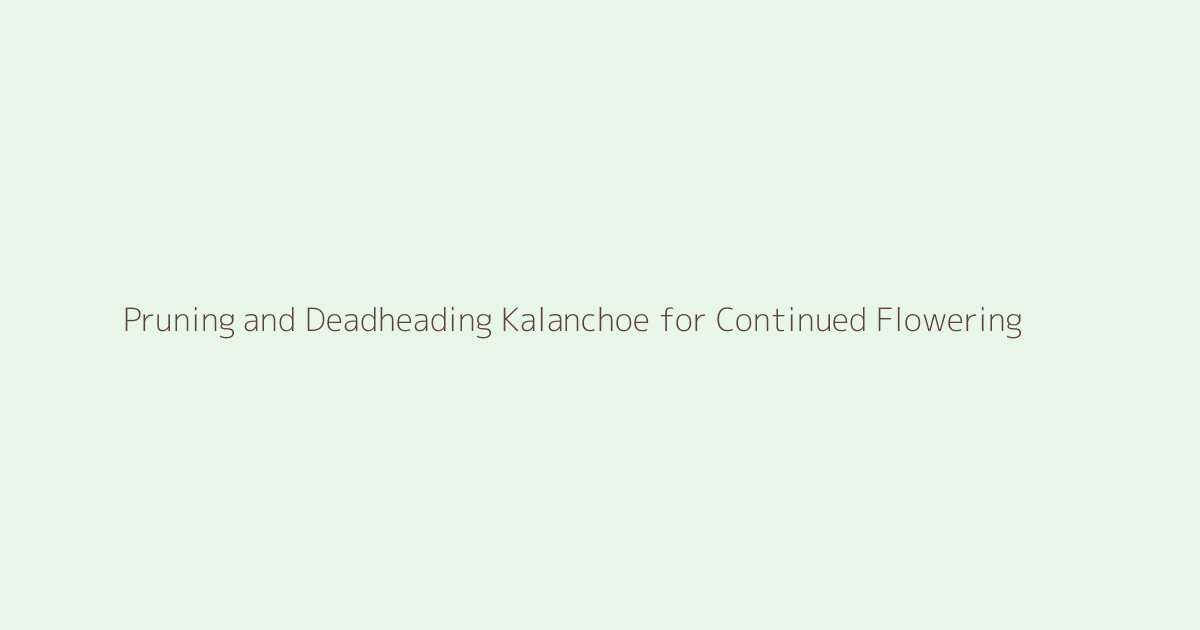Discover the secrets to nurturing vibrant kalanchoe plants indoors! As an experienced plant enthusiast, I’ll guide you through essential care techniques for these stunning succulents. From optimal light conditions to watering strategies, learn how to create the perfect environment for your kalanchoe to thrive and bloom year-round.
In this comprehensive guide, we’ll explore the intricacies of how to care for kalanchoe indoors. You’ll gain insights on soil selection, temperature control, and pest prevention, ensuring your plants remain healthy and beautiful. Whether you’re a seasoned gardener or a beginner, these tips will help you master the art of kalanchoe care and enjoy their colorful blossoms in your home.
Choosing the Right Location for Your Indoor Kalanchoe
As an expert in indoor plant care, I can confirm that choosing the ideal place for your kalanchoe is crucial for its wellness and longevity. These lively succulents, belonging to Madagascar, thrive in details conditions that we need to duplicate in our homes.
Optimal Light Exposure
Kalanchoes require bright, indirect light to prosper inside. Position your plant near a south or west-facing window, where it can receive ample sunlight without being revealed to extreme, direct rays. If you notice the leaves becoming light or stretched, it’s an indication that your kalanchoe requires a lot more light.
Temperature Considerations
Pick a spot where temperature levels stay regular, preferably in between 60 ° F to 85 ° F( 15 ° C to 29 ° C ). Prevent placing your kalanchoe near breezy home windows, air conditioning vents, or home heating resources, as sudden temperature level fluctuations can emphasize the plant.
Humidity Levels
While kalanchoes are tolerant of typical interior humidity, they favor somewhat drier air. Prevent placing them in normally moist locations like bathrooms or kitchen areas. If your home is particularly dry, you can raise humidity by placing a pebble tray full of water near the plant, however make sure the pot doesn’t rest straight in water.
Area and Air Circulation
Ensure your kalanchoe has enough space for air to flow easily around it. Excellent air flow helps avoid fungal problems and promotes healthy and balanced development. A location on a rack or table top, far from various other plants, is commonly ideal.
| Factor | Perfect Condition |
|---|---|
| Light | Brilliant, indirect |
| Temperature level | 60 ° F to 85 ° F (15 ° C |
| to 29 ° C) Humidity Average to somewhat dry | |
| Air Circulation | Great, far from other plants |
By very carefully thinking about these variables when selecting an area for your interior kalanchoe, you’ll develop a setting where your plant can grow and display its beautiful flowers for months at a time.
Optimum Light Requirements for Kalanchoe Plants
Kalanchoe plants prosper in bright, indirect light when expanded inside. These succulents originate from Madagascar and are adapted to warm settings, yet straight sunshine can be also extreme for them when maintained as houseplants. Preferably, place your kalanchoe near a south-facing or east-facing window where it can receive a lot of brilliant light throughout the day without being subjected to intense, straight sunlight rays.
Throughout winter season, when daylight hours are shorter, kalanchoe plants may take advantage of supplemental artificial lighting. You can use expand lights or fluorescent bulbs to provide the extra light they need to preserve healthy and balanced development and encourage flowering. Setting the lights regarding 6-12 inches above the plant and keep them on for 12-14 hours a day.
It’s crucial to keep in mind that inadequate light can bring about leggy development and lowered flowering. If you observe your kalanchoe extending or creating less flowers, it may be a sign that it requires a lot more light. On the various other hand, excessive straight sunlight can trigger leaf scorching and staining. Finding the best equilibrium is essential to preserving a healthy and vivid kalanchoe plant inside your home.
To guarantee your kalanchoe receives ideal light, rotate the pot every couple of weeks. This practice advertises even development and avoids the plant from leaning towards the source of light. Furthermore, clean the leaves frequently to remove dust, which can impede the plant’s ability to absorb light effectively.
Watering Techniques for Healthy Kalanchoe Growth
Proper watering is vital for the wellness and durability of interior kalanchoe plants. These succulents are adapted to dry settings and are delicate to overwatering, which can result in root rot and other issues. To make sure ideal development, adhere to these sprinkling techniques:
Watering Frequency
Enable the dirt to dry entirely in between waterings. Usually, this means sprinkling your kalanchoe when every 2-3 weeks, depending on environmental factors such as temperature level, moisture, and light exposure. Throughout the plant’s active expanding season (springtime and summer), you might need to water a little more often.
Watering Method
When watering, thoroughly saturate the soil until water drains from all-time low of the pot. This makes sure that water reaches the whole root system. Always make use of a pot with drain holes to protect against water from collecting at the bottom.
Seasonal Adjustments
Minimize sprinkling regularity throughout the plant’s dormant period in late autumn and winter. Throughout this time, the kalanchoe requires much less water to maintain its health.
| Season | Sprinkling Frequency |
|---|---|
| Spring/Summer (Active Growth) | Every 2-3 weeks |
| Fall/Winter (Dormancy) | Every 3-4 weeks |
Indicators of Improper Watering
Enjoy for these indicators to change your watering regimen:
- Overwatering: Yellowing fallen leaves, soft or mushy stems, mold on dirt surface area
- Underwatering: Drooping leaves, wrinkled or shriveled look
Water Quality
Usage space temperature water to stay clear of surprising the plant’s origins. Preferably, use filteringed system or rainwater, as kalanchoe can be conscious chemicals found in faucet water, such as chlorine and fluoride.
By adhering to these sprinkling techniques, you can preserve a healthy and balanced and lively kalanchoe plant inside your home, advertising lush development and abundant growing throughout its life cycle.
Dirt and Potting Considerations for Indoor Kalanchoe
Picking the best dirt and potting configuration is vital for the health of your indoor Kalanchoe. These succulents prosper in well-draining dirt that stops water from pooling around the origins. A combination of normal potting soil, perlite, and crude sand in equal components develops an ideal expanding tool. This combination ensures proper oygenation and drain while keeping enough moisture for the plant’s needs.
Choosing the Right Pot
When potting your Kalanchoe, choose for a container with appropriate drainage holes. Terra cotta pots are an excellent option as they enable excess dampness to vaporize with their permeable walls. The pot size should be symmetrical to the plant, typically simply 1-2 inches larger in diameter than the root round. Prevent extra-large pots, as they can lead to waterlogged soil and root rot.
Repotting Frequency
Kalanchoes typically do not call for regular repotting. Repot your plant every 2-3 years or when it outgrows its present container. The very best time to repot is in the spring, equally as the plant enters its energetic expanding phase. When repotting, carefully get rid of the plant from its old pot, tremble off excess soil, and evaluate the origins for any kind of indications of illness or rot prior to placing it in fresh soil.
Dirt pH and Amendments
Kalanchoes choose slightly acidic to neutral soil with a pH range of 6.0 to 7.5. If your soil is as well alkaline, you can include little amounts of peat moss or sulfur to decrease the pH. For included nutrients, integrate a slow-release fertilizer into the potting mix during repotting, following the maker’s instructions for interior succulents.
Temperature and Humidity Needs of Kalanchoe Plants
Kalanchoe plants grow in problems that simulate their native exotic and subtropical environments. To make sure optimal growth and blooming of your indoor kalanchoe, it’s essential to preserve suitable temperature and moisture degrees.
Temperature Requirements
Kalanchoe plants prefer cozy temperatures and are delicate to cold. For best outcomes:
| Temperature Range | Perfect Conditions |
|---|---|
| Daytime | 60-85 ° F( |
| 15-29 ° C)Nighttime 50-70 ° F( | |
| 10-21 ° C)Minimum 40 ° F( |
4 ° C) Avoid positioning your kalanchoe near breezy windows or cooling vents, as abrupt temperature changes can stress the plant. During winter months, keep them away from cold windowsills to stop damages from cool air.
Humidity Considerations
While kalanchoe plants are typically forgiving of ordinary indoor humidity levels, they can take advantage of slightly greater moisture, particularly during completely dry winter season months. Perfect humidity levels range from 40-60%. To enhance humidity:
- Use a pebble tray filled with water beneath the pot
- Team plants together to produce a microclimate
- Make use of an area humidifier for bigger rooms
Prevent misting kalanchoe leaves straight, as this can bring about fungal concerns. Rather, focus on raising ambient moisture around the plant.
Seasonal Adjustments
To encourage blooming, kalanchoe plants take advantage of a duration of cooler temperature levels and reduced daytime hours in late autumn or early winter months. Supply:
| Condition | Requirement |
|---|---|
| Temperature level | 50-60 ° F( 10-15 ° C )for 6-8 weeks |
| Light | 12-14 hours of total darkness daily |
After this period, return the plant to normal growing problems to boost flower production. By thoroughly handling temperature and humidity, you can ensure your indoor kalanchoe continues to be healthy and balanced and vibrant throughout the year.
Fertilizing Your Indoor Kalanchoe for Optimal Blooming
Correct fertilizing is important for maintaining healthy and balanced development and advertising lively blossoms in your interior kalanchoe. These succulents are not heavy feeders, but they do benefit from normal, well balanced nutrition. To take care of kalanchoe indoors, adhere to these feeding guidelines:
Fertilizer Type
Use a well balanced, water-soluble fertilizer with an NPK proportion of 10-10-10 or 20-20-20. Conversely, you can choose a fertilizer particularly developed for succulents and cacti, which usually has a lower nitrogen content.
Feeding Frequency
Interior kalanchoe plants need to be fed every 4-6 weeks during their energetic growing period, which is usually spring and summer. Minimize or entirely quit fertilizing throughout the loss and cold weather when the plant’s growth naturally reduces.
Application Method
Weaken the plant food to half the strength recommended on the plan to avoid over-fertilization. Use the diluted service to wet dirt after watering your kalanchoe. This aids stop origin burn and makes certain also distribution of nutrients.
Timing for Blooming
To motivate flowering, change to a high-phosphorus fertilizer (such as 5-10-5) about a month before you want your kalanchoe to flower. This increase in phosphorus promotes bud formation and improves the plant’s blooming capacity.
Indications of Over-fertilization
Beware not to over-fertilize, as this can result in fallen leave melt, stunted growth, and even plant fatality. Indications of over-fertilization consist of brown leaf suggestions, wilting, and a white crust on the dirt surface area. If you notice these signs, flush the dirt with plain water and decrease plant food application.
Organic Alternatives
For those choosing organic options, garden compost tea or watered down worm spreadings can be made use of as natural plant foods for kalanchoe. These give mild, slow-release nutrients that support healthy and balanced development without the danger of chemical burn.
Pruning and Deadheading Kalanchoe for Continued Flowering
Correct pruning and deadheading are necessary for keeping the wellness and appearance of your indoor kalanchoe plants. These practices motivate proceeded flowering and assist keep a portable, bushy growth practice.
Deadheading
Deadheading is the procedure of getting rid of spent blossoms from your kalanchoe. This method:
- Motivates the plant to produce more blooms
- Stops the plant from losing power on seed manufacturing
- Improves the total appearance of the plant
To deadhead, just squeeze off the faded flowers at the base of the stem utilizing tidy, sharp scissors or your fingers.
Pruning
Pruning your kalanchoe helps maintain its form and promotes bushier development. Here’s an overview to pruning your kalanchoe:
| When to Prune | How to Prune |
|---|---|
| After blossoming cycle | Cut back stems to regarding 4-6 inches |
| During growing season | Squeeze back growing pointers to urge branching |
| Anytime | Get rid of dead or unhealthy leaves and stems |
When trimming, constantly make use of clean, sharp tools to stop damage and disease transmission. Make cuts simply above a fallen leave node or set of leaves to encourage new development.
Motivating Reblooming
To motivate your kalanchoe to rebloom, you can control its light exposure. Kalanchoes are short-day plants, meaning they bloom in feedback to longer periods of darkness. To activate flowering:
- Decrease light direct exposure to 8-10 hours per day for regarding 6 weeks
- Keep the plant in total darkness for the continuing to be 14-16 hours
- Preserve routine treatment throughout this period
Hereafter therapy, return to regular light problems, and your kalanchoe needs to begin to create new blossom buds.
Usual Pests and Diseases Affecting Indoor Kalanchoe
While Kalanchoe plants are normally resistant, they can still succumb numerous parasites and illness when expanded inside. Attentive monitoring and prompt activity are key to preserving healthy and balanced Kalanchoe plants.
Usual Pests
1. Mealybugs: These small, white, cotton-like insects usually cluster in fallen leave axils and stems. Treat with insecticidal soap or neem oil.
2. Crawler mites: Tiny arachnids that create stippling on fallen leaves. Boost moisture and use miticides if invasion is severe.
3. Aphids: Small, soft-bodied insects that gather on brand-new growth. Remove with a solid water spray or use insecticidal soap.
Common Diseases
1. Origin rot: Caused by overwatering or inadequate drain. Make sure appropriate watering practices and well-draining dirt.
2. Fine-grained mold: White, grainy fungal growth on leaves. Improve air flow and stay clear of overhead watering.
3. Fallen leave spot: Brown or black spots on leaves, typically brought on by fungal infections. Get rid of impacted fallen leaves and stay clear of moistening foliage.
Avoidance and Treatment
Regular assessment of your Kalanchoe plants is vital for early discovery of insects and illness. Preserve appropriate treatment methods, including suitable watering, light exposure, and air flow. If issues continue, think about using organic or chemical therapies particular to the problem at hand. Constantly isolate influenced plants to stop spread to other houseplants.
Propagating Kalanchoe: Expanding Your Indoor Collection
Circulating Kalanchoe plants is an outstanding method to increase your interior collection and share these attractive succulents with loved ones. There are 2 key approaches for circulating Kalanchoe: leaf cuttings and stem cuttings.
Fallen leave Cuttings
To circulate Kalanchoe using leaf cuttings:
- Select a healthy, fully grown leaf from the plant
- Gently spin or reduce the fallen leave off at the base
- Enable the cut end to callus for 1-2 days
- Area the fallen leave on well-draining succulent soil
- Haze the dirt gently to keep it a little moist
- Wait on origins and little plantlets to develop (usually 2-3 weeks)
Stem Cuttings
For stem reducing proliferation:
- Choose a healthy stem with a number of fallen leaves
- Cut the stem 3-4 inches listed below the top growth
- Eliminate lower fallen leaves, leaving 2-3 pairs on top
- Enable the cut end to callus for 1-2 days
- Plant the reducing in well-draining delicious soil
- Water sparingly up until roots develop (concerning 2-3 weeks)
Proper look after newly propagated Kalanchoe is essential for successful development. Keep the young plants in intense, indirect light and maintain a little damp soil. When developed, treat them as mature Kalanchoe plants, complying with the treatment guidelines for interior growing.
| Breeding Method | Success Rate | Time to Root |
|---|---|---|
| Leaf Cuttings | 70-80% | 2-3 weeks |
| Stem Cuttings | 80-90% | 2-3 weeks |
By grasping these propagation techniques, you can conveniently broaden your Kalanchoe collection and enjoy a selection of these colorful, low-maintenance succulents in your interior garden.
FAQs: How to Care for Kalanchoe Indoors
Q1: How often should I water my indoor kalanchoe?
A: Water your kalanchoe every 2-3 weeks, allowing the soil to dry completely between waterings. Reduce frequency during fall and winter when the plant is dormant.
Q2: What type of light does a kalanchoe need indoors?
A: Kalanchoes thrive in bright, indirect light. Place them near a south or west-facing window, but avoid direct sunlight which can scorch the leaves.
Q3: How can I encourage my kalanchoe to bloom again?
A: To trigger reblooming, provide your kalanchoe with 14-16 hours of complete darkness daily for about 6 weeks. This mimics short winter days and stimulates flower production.
Q4: What’s the ideal temperature range for indoor kalanchoes?
A: Maintain temperatures between 60°F to 85°F (15°C to 29°C) during the day, and slightly cooler at night. Avoid exposing the plant to temperatures below 50°F (10°C).
Q5: How often should I fertilize my indoor kalanchoe?
A: Fertilize your kalanchoe every 4-6 weeks during spring and summer with a balanced, water-soluble fertilizer diluted to half strength. Reduce or stop fertilizing in fall and winter.
Q6: What type of soil is best for kalanchoes?
A: Use a well-draining potting mix designed for succulents. You can create your own by mixing equal parts potting soil, perlite, and coarse sand.
Q7: How do I propagate my kalanchoe?
A: Kalanchoes can be easily propagated through leaf or stem cuttings. Allow cuttings to callus for a day or two before planting in well-draining soil. Roots typically develop in 2-3 weeks.
Q8: What are common pests that affect indoor kalanchoes?
A: Watch out for mealybugs, spider mites, and aphids. Regularly inspect your plant and treat any infestations promptly with insecticidal soap or neem oil.
Q9: How often should I repot my kalanchoe?
A: Repot your kalanchoe every 2-3 years or when it outgrows its current container. The best time to repot is in spring, just as the plant enters its active growing phase.
Q10: Can kalanchoes tolerate low humidity indoors?
A: Yes, kalanchoes are quite tolerant of average indoor humidity levels. However, they may benefit from slightly higher humidity, especially during dry winter months. You can increase humidity by using a pebble tray or grouping plants together.





